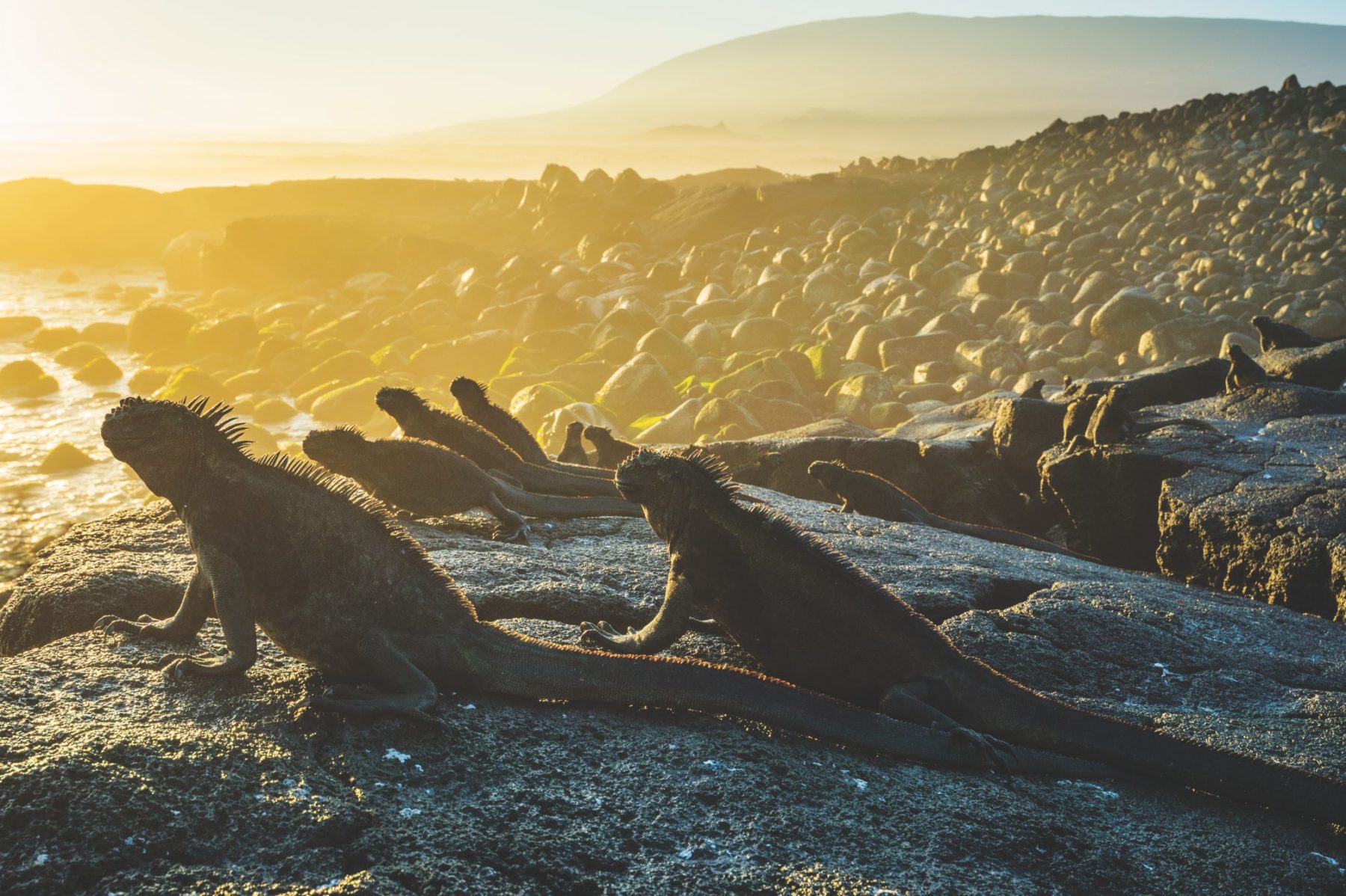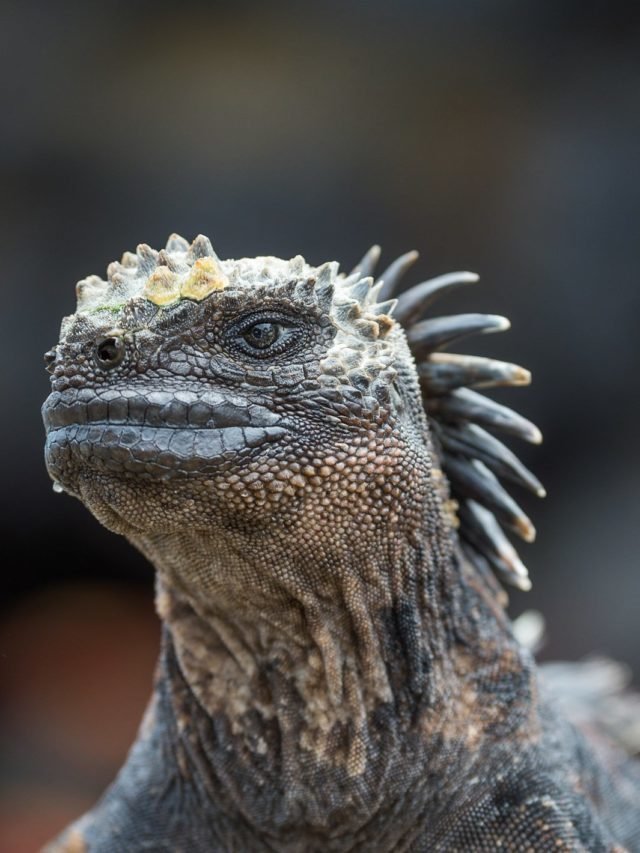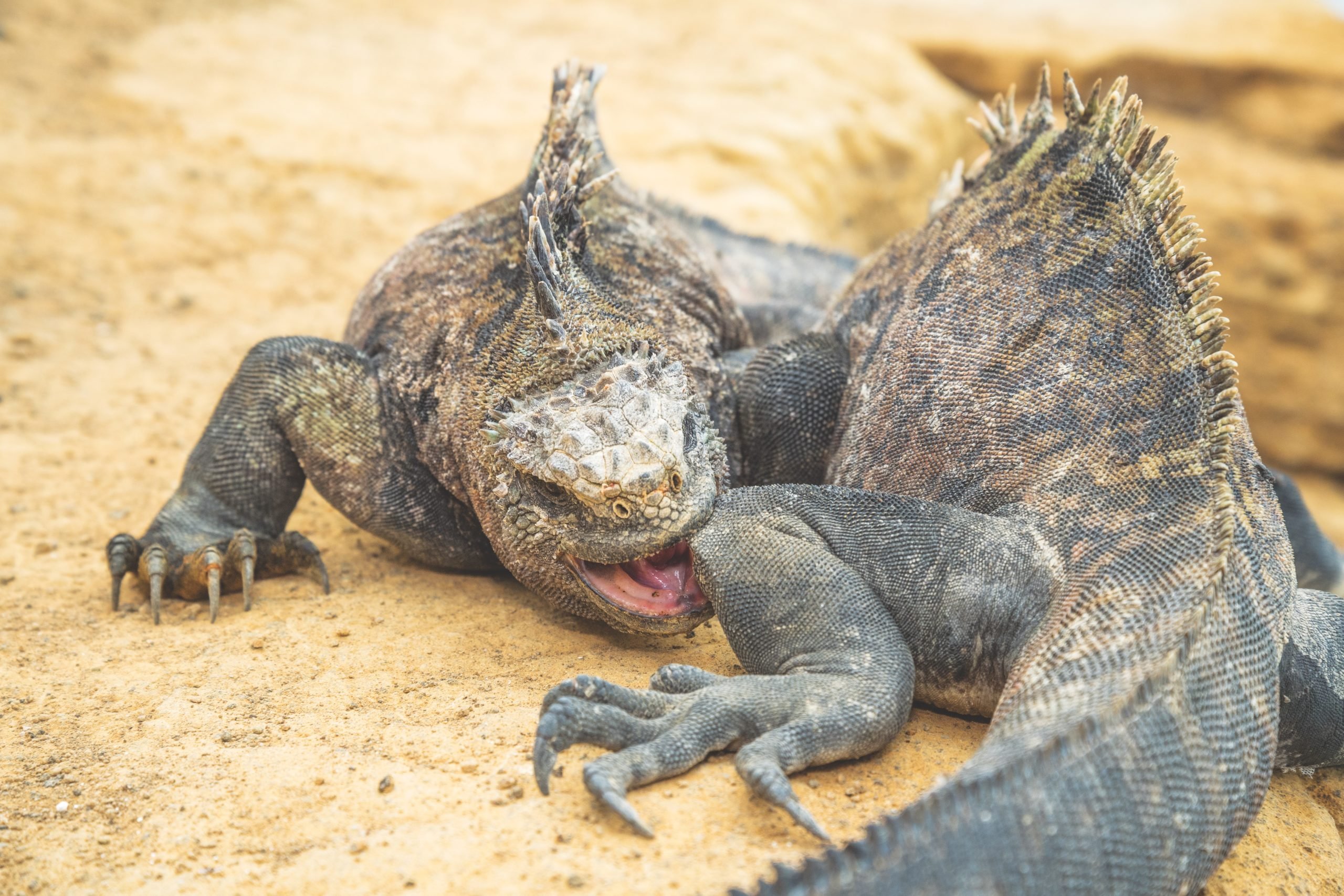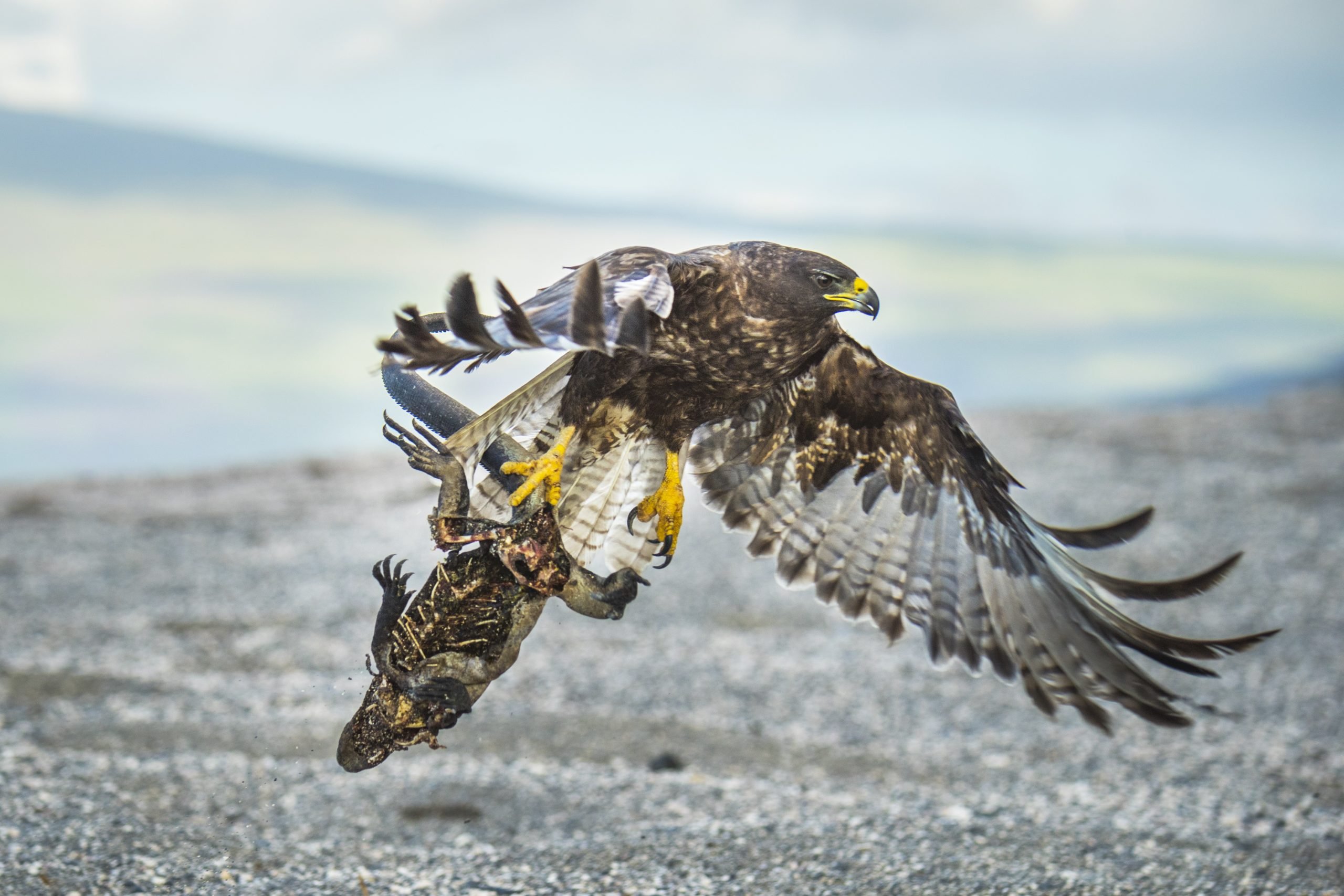Many of the stark, black basaltic lava shorelines of the Galápagos Islands bristle with hundreds, if not thousands, of equally dark, metre-long lizards. They’re marine iguanas and, with their bodies often intertwined and overlapping, they lie immobile for hours on end, stirring only to reorient themselves according to the intensity of the sun’s rays.
Without moving position they occasionally spurt out a sneeze-like spray of concentrated salt water from their round, scaly nostrils. This briny mist settles and dries in a whitish crust on surrounding surfaces, both scaly skin and corrugated lava rock.
Come low tide, a slow wave of movement spreads among the prone bodies as each animal extricates itself from the pile and begins making its way towards the crashing waves nearby. One by one they resolutely slip from sun-warmed shore into frigid sea in search of their favourite seaweed pastures.
Suddenly animated, the smaller ones feed hungrily on jutting boulders along the wave-washed foreshore, scraping the short crop of glistening green and red algae with specialised, rasp-like teeth. Larger individuals ignore the semi-exposed rocks, and switch from crawling to swimming by launching themselves into the water and undulating their long tails from side to side while trailing their legs limply.
Doggedly they make their way through and under the crashing surf, until they too reach their chosen grazing spots. An internal clock has started ticking for them all and they must feed quickly, before their core body temperature drops to where their muscles become too numb for them to be able to return to high ground.
It’s a biological balancing act that these animals have achieved to perfection, as evidenced by their astounding abundance in places where few other animals can survive. A unique set of evolutionary and geographical features has made it possible for the Galápagos marine iguana to become the only lizard in the world that depends entirely on the sea for its existence.
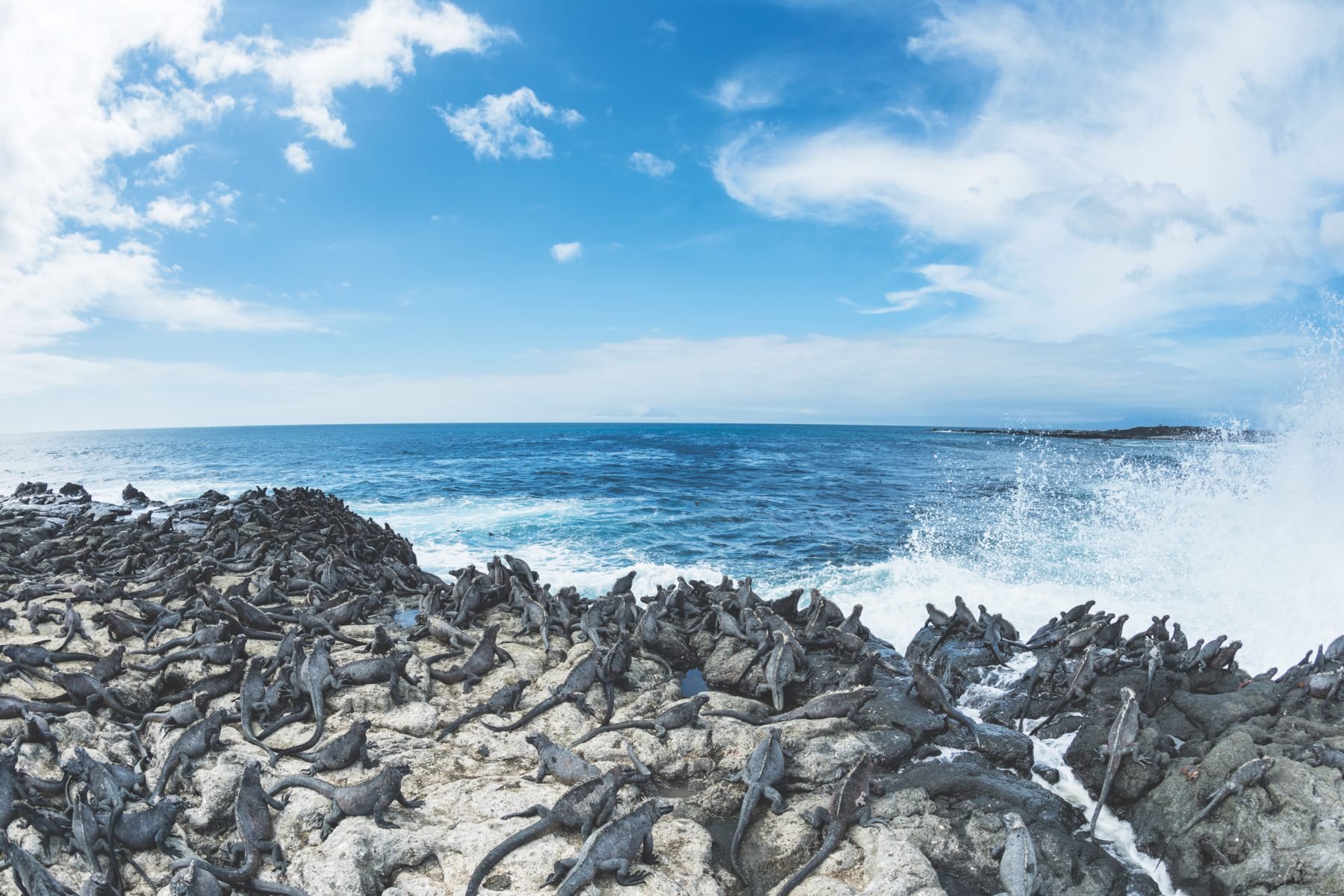
I grew up in the Galápagos Islands. Once, as a child while fossicking along the shoreline, I absentmindedly stepped on what I thought was a lava rock ledge only to find I’d startled a sun-basking marine iguana. This behaviour by these remarkable lizards helps show why they could have evolved only in the Galápagos, and nowhere else.
The reasons are many. First, for a reptile to feed in the sea, unless you’ve got the jaws and stealth of a croc, a piscivorous diet is beyond reach in a world dominated by fleet-swimming fishes, whether predator or prey. Second, to embrace the alternative and become a marine herbivore you need a secure supply of seaweed that thrives in cold, nutrient-rich waters, such as is provided by the upwellings of the Humboldt Current of South America or the equally cold Benguela Current of Namibia.
But how would a cold-blooded reptile find enough solar heat after each feeding trip to regain the body temperature needed to digest its meal (roughly 36°C to 38°C), not to mention avoid being eaten by predators during long hours of basking sluggishly on the shoreline while remaining chilled?
What was needed was isolated, predator-free islands surrounded by cool, nutrient-laden seas but bathed in equatorial sunshine. Take a look at the physical globe and you’ll find only one place that fits the bill: the Galápagos.
Of course, that presents the first hurdle – getting there. But the Galápagos, smack-bang on the Equator, is nowhere near as isolated as many other island groups throughout the tropics. Less than 1000km west from the coast of Ecuador, they are flushed by a near-constant flow of ocean currents that deviate north-west from the South American coastline. During heavy rains, such currents may carry with them all manner of flotsam disgorged from continental rivers, including hapless vertebrates clinging to uprooted trees. The two or three weeks it would take for such forlorn rafts to drift to the islands’ shores are long enough to kill most mammals and amphibians, but, thanks to their slower metabolism, not so for reptiles. No wonder, then, that these represent a disproportionate share of the Galápagos fauna – with the exception of seabirds, of course, which flew there.
Yet, for the iguanas to become marine, geography was only the beginning. Numerous physiological adaptations and mutations were needed for natural selection to play its wondrous tricks and design a new beast. In random format, here are the results of this greatest of natural experiments: black skin to better absorb heat from the sun; enhanced salt-excreting glands inside the nostril cavity (most lizards have this but not so well developed), to expel excess salt from sea water because there’s no fresh water in marine iguana habitat; behavioural thermoregulation in the absence of shade, whereby heat can be absorbed, or avoided, depending on the animal’s position relative to the sun – either by being sprawled on warm rocks with the back perpendicular to sun rays versus raised off the ground and facing into the sun to be able to shade the body from the shoulders down; the ability, upon diving, to quickly reduce blood flow to irrigate only essential organs and so conserve both heat and oxygen; a flattened tail and strong muscles to propel themselves snakelike in the water; extra-sharp hooked claws on all 10 toes to be able to cling to the seabed against strong currents and crashing waves; a rounded, blunt snout and rasp-like teeth placed at the outer edge of the jaws, making it possible to efficiently crop algae off irregular rock surfaces.
When famed British naturalist Charles Darwin – father of the theory of evolution – visited the Galápagos in 1835, he was distinctly unimpressed by the marine iguanas he encountered, jotting descriptions in his diary such as “repulsive”, “sluggish”, “imps of darkness”. Still, he was sufficiently intrigued to conduct some crude experiments on their behaviour, commenting incredulously that, when forcibly thrown in the sea, the reptiles swam straight back to shore to be chucked in again. (They were surely cold.)
He also recorded a fellow crewman dunking an iguana in a weighted sack to find it none the worse for wear when raised to the surface an hour later! We now know a lot more about the subtleties of their behavioural and physiological adaptations, but that certainly makes them no less fascinating.
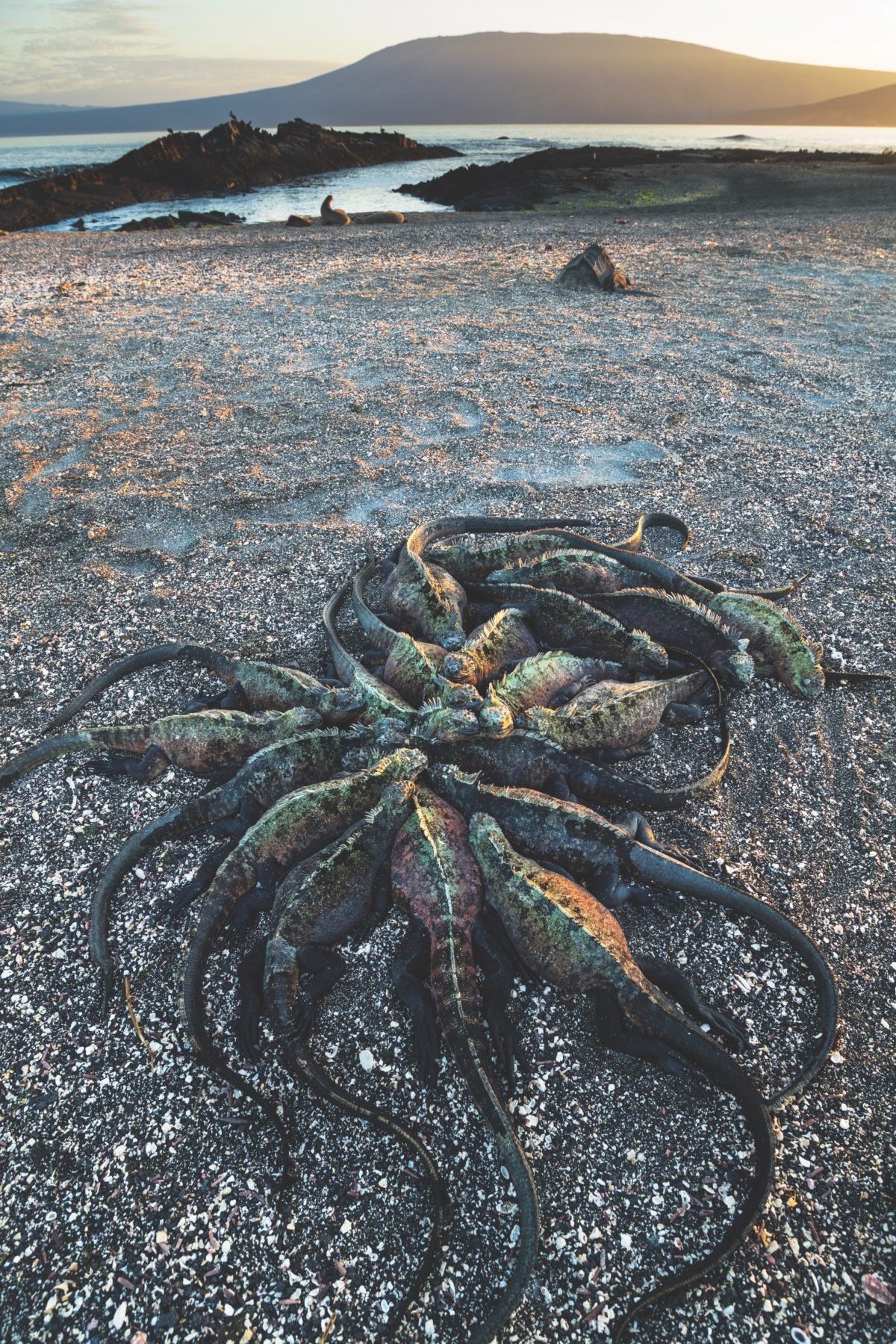
I must have also seen marine iguanas when I first arrived in the Galápagos with my pioneering parents from Belgium, on the day of my second birthday, 66 years ago. But I certainly don’t remember it. In fact, I have probably forgotten myriad other encounters since then, because every time I see a new marine iguana, I’m filled with wonder all over again.
Dark and often inactive they may be, but, to me at least, they are anything but repulsive. I see art in their curving postures and classic silhouettes and the symmetrical patterns of their scales. To encounter an iguana beneath the waves is to see the implausible become real. They seem so out of place yet so very much at home clinging to undersea rocks, munching on lush marine pastures, their tails swishing with the to-and-fro of the wave surge. Little colourful wrasses and blennies usually accompany them, snatching invertebrates suddenly exposed by torn-away plant cover.
Iguanas may graze like this for five or so minutes at a time, several dives in a row. Then their inner thermostat goes into alarm mode and they swim up and away, heading unerringly for shore. Where the best algae grow, the warm, beckoning lava rock shore is often thrashed by heaving surf, swirling and pounding the swimming iguanas mercilessly while their energy reserves dwindle as they dangerously cool down.



Most will make the daily feeding trip unscathed, but occasionally some are swept out to sea. With much luck they may even end up washing ashore on another island. This explains why marine iguanas are found everywhere in the Galápagos, although such accidental crossings remain rare enough that each island population shows individual characteristics of colour and size, none more so than those found on the southern (upcurrent) islands of Española and Floreana.
The iguanas on these islands are medium-sized, but their outstanding feature is the brilliant colouration they acquire during the breeding season, especially by the larger males whose back and forelegs become gaudily blotched with splashes of pink or carmine red and copper-oxide green. Because this occurs towards the end of the year, they are sometimes dubbed the “Christmas iguanas”. At this time, when they’re far from sluggish, the males may travel for miles, walking along the rocky shores or swimming across entire bays in search of areas where females are likely to gather daily.
Each staking out a tiny territory among the females, they defend their patch aggressively against all trespassers. High-stake battles – featuring head-butting, wrestling and biting – sometimes last for hours. The victors are, however, remarkably gentle in their approach to winning the females’ favour.
A male will approach and circle around a female jerkily, head nodding all the while. If she is not interested, she nods her head in return and he desists. If she’s receptive, she simply does nothing and allows him to grasp her by the scruff of the neck for mating.
Two months later, it’s the females’ turn to travel and fight. Each is looking for – and prepared to battle over – a patch of sand above tidal reach in which to bury a small clutch of up to six eggs With their respective jobs done, males and females return to their favourite living and feeding areas, where they cosily spend the rest of the year, often sharing body heat in untidy piles.
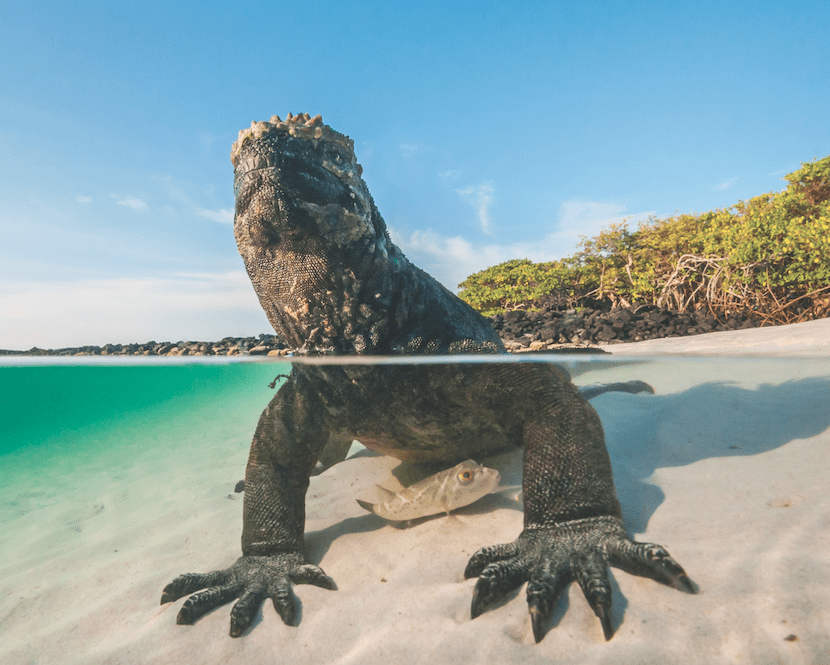
Three months pass before tiny hatchlings first appear, raising their heads out of the sand to confront a dangerous world of hungry herons, frigatebirds, Galápagos hawks and Galápagos racer snakes. As often happens with baby reptiles, many will not make it through their first day out of the nest. But enough survive. They need to move quickly to find a deep and spacious crevice in the rocks, preferably surrounded by adult iguanas, to serve as a creche and hideout, as near as possible to a seaweed-covered foreshore that’s exposed at low tide where they can feed. Too small to survive diving into cold water, they will not begin swimming until they’re several years old and need more algal volume than the intertidal zone can provide.
During their juvenile years they lead discreet but alert lives in the company of Sally Lightfoot crabs that may be bigger than they are. They’re always on the lookout for predators. If they make it to adulthood, they can mostly relax, except for the females, which are subject to hawk predation while nesting on open beaches. Barring such mishaps, a marine iguana’s life expectancy is believed to be 30–40 years.
There’s nothing that plunges me more reassuringly into the heart of that unique island atmosphere, which underpins who I am deep in my soul, than a peaceful walk along a deserted lava rock shore at the end of the day. It’s an experience shared with the intermingled shapes of spiky iguana crests backlit like a cut-out montage against a flaming Galápagos sunset.
Travel with us
The Australian Geographic Society is partnering with Hurtigruten Expeditions to explore the Galápagos Islands with our readers in August/September 2022.
The voyage will be hosted by AG Editor-in-chief, Chrissie Goldrick.
Departs 31 August 2022 aboard small ship MS Santa Cruz II.
From $9989/ per person twin share
Find out more: contact Hurtigruten Expeditions or phone 1300 322 062.
